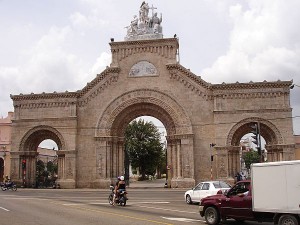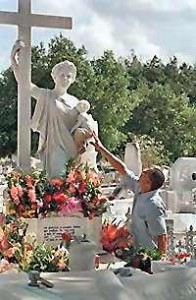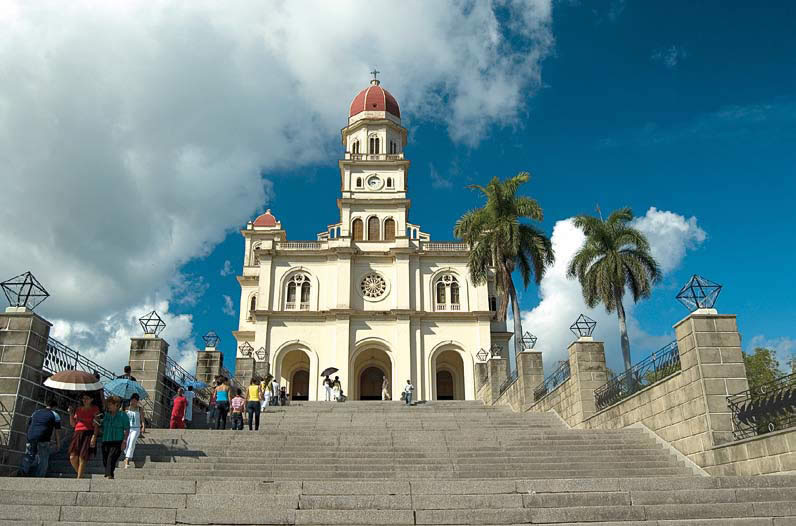Colon Cemetery in Havana was officially founded on October 30, 1871 and dedicated to the great navigator and discoverer of the island. It covers an area of 56 hectares, so it is considered the largest in America. The Colon Cemetery more fully in the Spanish language Cementerio de Cristóbal Colón was founded in the Vedado neighbourhood of Havana, Cuba on top of Espada Cemetery. Is noted for its many elaborately sculpted memorials. It is estimated that today the cemetery has more than 500 major mausoleums, chapels, and family vaults.
This Cemetery has a 75-foot (23 m)-high monument to the firefighters who lost their lives in the great fire of May 17, 1890. As baseball is a leading sport in Cuba, the cemetery has two monuments to baseball players from the Cuban League. The first was erected in 1942 and the second in 1951 for members of the Cuban Baseball Hall of Fame.
In February 1898, the recovered bodies of sailors who died on the United States Navy battleship Maine were interred in the Colon Cemetery. In December 1899 the bodies were disinterred and brought back to the United States for burial at Arlington National Cemetery.
With more than 800,000 graves and 1 million interments, space in the Colon Cemetery is currently at a premium and as such after three years remains are removed from their tombs, boxed and placed in a storage building.
The first thing that strikes us is the baroque entrance of the cemetery, with a triumphal arch built by the Spanish architect Calixto Arellano Loire, with reliefs and sculptures in Carrara marble, the Cuban José Vilalta de Saavedra. Once inside, divided by avenues are wide cemeteries colonial mansions, with arches, domes and stained glass of great beauty, even tombs of Egyptian funerary style, and a pantheon with a replica of an Italian church in miniature, made with an incredible delicacy. The roads remain decorated with palms and flame trees, which provide a nice break to walkers who use the cemetery to catch up and the visitors themselves of the necropolis.
Among his most notable pieces of sculpture is the monument dedicated ten meters high to a group of firefighters tragically killed in action, the mausoleum erected statues of the eight medical students killed by the Spanish colonial army, and sculpture that reproduces Goyri the lady Amelia de la Hoz, better known as “The Miracle”.
On this tomb has woven a beautiful legend. They say that this young man had to wait until his father died so he could marry the man chosen of her heart. However, during her first birth both die. She is buried with the child at his feet and say that after years, when they uncovered the tomb, they found the baby in her arms. Therefore receives daily La Milagrosa devotees with flowers and presents, actually being able to compete with the other sacred figures. Figures such as Dulce Maria Loynaz, Alejo Carpentier and popular singers Mercedita Valdés and Rita Montaner also rest in this cemetery, accompanied by the love and warmth of the cuban people.
Other Notables Interments:
Santiago Álvarez (1919–1998), filmmaker * Manuel Arteaga y Betancourt, Roman Catholic Cardinal * Beatriz Azurduy Palacios (1952–2003), filmmaker * Hubert de Blanck (1856–1932), composer * José Raúl Capablanca (1888–1942), world chess champion * Federico Capdevila (?-1898), Lieutenant Colonel of Spanish Army who defended the cuban students of Medicine in 1871 * Alejo Carpentier (1904–1980), novelist * Eduardo Chibás (1907–1951), politician * Juan Chabás (1910–1954), author * Ibrahim Ferrer (1927–2005), musician * Candelaria Figueredo (1852–1914), patriot in the Cuban struggle for independence from Spain * José Miguel Gómez (1858–1921) president of Cuba * Máximo Gómez (1836–1905), Cuban-Dominican military hero * Ruben Gonzalez (1919–2003), Cuban Pianist from Buena Vista Social Club * Nicolás Guillén (1902–1989), poet * Nicolás Guillén Landrián (1938–2003), Filmmaker and painter * Tomás Gutiérrez Alea (1928–1996), filmmaker * Harrison E. Havens (1837–1916), United States Congressman * Alberto Korda (1928–2001), photographer * José Lezama Lima (1910–1976), writer, poet * Dulce María Loynaz (1902–1997), poet, novelist * Adolfo Luque (1890–1957), Major League Baseball starting pitcher * Mary McCarthy Gomez Cueto (1900–2009), Havana socialite and musician * Armando Marsans (1887–1960) Major League Baseball outfielder * William Alexander Morgan (1928–1961), American Fighter * Fernando Ortiz (1881–1969), ethnomusicologist
German Pinelli (1907–1996), journalist, actor * Chano Pozo (1915–1948), musician, pioneer of Afrocuban jazz * Juan Ríus Rivera (1848–1924), Cuban-Puerto Rican military hero * Lola Rodríguez de Tió (1848–1924), Cuban-Puerto Rican poetess * Dr. Francisco Taquechel (1869–1955), Notable doctor, founder (1898) and director of the Farmacia Taquechel, Old Havana.
Sources: HavanaInside/InternetPhotos/TheCubanHistory.com
Colón Cementery, Havana/ The Cuban History/ Arnoldo Varona, Editor
EL CEMENTERIO DE COLON, HABANA
El Cementerio de Colón en La Habana fue fundado oficialmente el 30 de octubre de 1871 y dedicado al gran navegante y descubridor de la isla. Cubre un área de 56 hectáreas, por lo que se considera el más grande de América. El Cementerio de Colón con más detalle en la lengua española se llama Cementerio de Cristóbal Colón y fue fundado en el Barrio del Vedado en La Habana, Cuba sobre el anterior existente cementerio de Espada. Es conocido por sus muchos monumentos esculpidos detalladamente. Se estima que en la actualidad el cementerio tiene más de 500 mausoleos, capillas, grandes y panteones familiares.
Este cementerio tiene un monumento de 75 pies (23 m) de altura dedicado a los bomberos que perdieron la vida en el gran incendio del 17 de mayo de 1890. Como el béisbol es un deporte líder en Cuba, el cementerio cuenta con dos monumentos a los jugadores de béisbol de la Liga Cubana. El primero fue construido en 1942 y la segunda en 1951 por miembros del Salón de la Fama del béisbol cubano.
En febrero de 1898, los cuerpos recuperados de los marineros que murieron en la Marina de Estados Unidos acorazado Maine fueron enterrados en el Cementerio de Colón. En diciembre de 1899 los cuerpos fueron desenterrados y llevados de regreso a Estados Unidos para su entierro en el Cementerio Nacional de Arlington.
Con más de 800.000 tumbas y enterramientos de 1 millón, el espacio en el Cementerio de Colón se encuentra actualmente en un premio y, como tal, después de tres años se retiran los restos de sus tumbas, en caja y se coloca en un edificio de almacenamiento.
Lo primero que llama la atención es la entrada barroca de la necrópolis, con un arco del triunfo construido por el arquitecto español Calixto Arellano de Loira, con relieves y esculturas en mármol de carrara, del cubano José Vilalta de Saavedra. Ya en su interior, divididos por avenidas, aparecen panteones a escala de las mansiones coloniales, con arcos, cúpulas y vitrales de gran belleza, incluso tumbas de estilo funerario egipcio, y un panteón con una réplica de una iglesia italiana en miniatura, realizada con una exquisitez increíble. Los caminos permanecen adornados con flamboyanes y palmas, que proporcionan un agradable descanso a caminantes que utilizan el cementerio para acortar distancias y a los propios visitantes de la necrópolis.
Entre sus piezas escultóricas más notorias está el monumento de diez metros de alto dedicado a un grupo de bomberos muertos trágicamente en acto de servicio; las estatuas del mausoleo erigido a los ocho estudiantes de Medicina asesinados por el ejército colonial español; y la escultura que reproduce a la dama Amelia Goyri de la Hoz, más conocida como “La Milagrosa”.
Sobre esta tumba se ha tejido una bella leyenda. Cuentan que esta joven tuvo que esperar que su padre muriera para poder casarse con el hombre elegido de su corazón. Sin embargo, durante su primer parto el niño y ella fallecen. Es enterrada con el niño a sus pies y dicen que al cabo de los años, al destapar la tumba, encontraron la criatura en sus brazos. Por todo ello La Milagrosa recibe a diario a devotos con flores y presentes, llegando a competir realmente con las restantes figuras sacras. Figuras como Dulce María Loynaz, Alejo Carpentier y las cantantes populares Mercedita Valdés y Rita Montaner descansan también en este cementerio, acompañadas del amor y el calor de todo su pueblo.
Otros Notables en el Cementerio:
Santiago Álvarez (1919–1998), filmmaker * Manuel Arteaga y Betancourt, Roman Catholic Cardinal * Beatriz Azurduy Palacios (1952–2003), filmmaker * Hubert de Blanck (1856–1932), composer * José Raúl Capablanca (1888–1942), world chess champion * Federico Capdevila (?-1898), Lieutenant Colonel of Spanish Army who defended the cuban students of Medicine in 1871 * Alejo Carpentier (1904–1980), novelist * Eduardo Chibás (1907–1951), politician * Juan Chabás (1910–1954), author * Ibrahim Ferrer (1927–2005), musician * Candelaria Figueredo (1852–1914), patriot in the Cuban struggle for independence from Spain * José Miguel Gómez (1858–1921) president of Cuba * Máximo Gómez (1836–1905), Cuban-Dominican military hero * Ruben Gonzalez (1919–2003), Cuban Pianist from Buena Vista Social Club * Nicolás Guillén (1902–1989), poet * Nicolás Guillén Landrián (1938–2003), Filmmaker and painter * Tomás Gutiérrez Alea (1928–1996), filmmaker * Harrison E. Havens (1837–1916), United States Congressman * Alberto Korda (1928–2001), photographer * José Lezama Lima (1910–1976), writer, poet * Dulce María Loynaz (1902–1997), poet, novelist * Adolfo Luque (1890–1957), Major League Baseball starting pitcher * Mary McCarthy Gomez Cueto (1900–2009), Havana socialite and musician * Armando Marsans (1887–1960) Major League Baseball outfielder * William Alexander Morgan (1928–1961), American Fighter * Fernando Ortiz (1881–1969), ethnomusicologist
German Pinelli (1907–1996), journalist, actor * Chano Pozo (1915–1948), musician, pioneer of Afrocuban jazz * Juan Ríus Rivera (1848–1924), Cuban-Puerto Rican military hero * Lola Rodríguez de Tió (1848–1924), Cuban-Puerto Rican poetess * Dr. Francisco Taquechel (1869–1955), Notable doctor, founder (1898) and director of the Farmacia Taquechel, Old Havana.
Sources: HavanaInside/InternetPhotos/TheCubanHistory.com
Colón Cementery, Havana/ The Cuban History/ Arnoldo Varona, Editor





